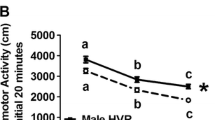Abstract
Mice ran in a circular runway. Some received milk at every third circuit in a designated direction, clockwise or counterclockwise, in daily 1000-s sessions. Under control conditions, about 10 times as many circuits were made in the reinforced direction as in the non-reinforced direction. Cocaine (10, 30, 100 µM/kg) had little effect on the total number of circuits, but progressively increased the number in the non-reinforced direction. Chlorpromazine (1, 3, 10, 30 µM/kg) caused a monotonic decrease in total number of circuits and in number in non-reinforced direction. At the highest doses the proportion in the non-reinforced direction was increased. Mice, untrained in the runway and with no reinforcement of circuits in either direction, made many fewer total circuits than when running was reinforced and about equal numbers were in clockwise and in counterclockwise directions. Cocaine greatly increased the total number of circuits. As in the subjects whose running was reinforced, cocaine led to a much higher tendency for mice to run in a single direction. The similarities between the tendency to run in one direction after cocaine and the rotational behavior of rodents seen after cocaine and amphetamine suggest a common mechanism.
Similar content being viewed by others
References
Dark KA, Ellman G, Peeke HVS, Galin D, Reus VI (1984) Sex differences and asymmetries of catecholamines: relation to turning preferences. Pharmacol Biochem Behav 20:327–330
Dews PB (1953) The measurement of the influence of drugs on voluntary activity in mice. Br J Pharmacol 8:42–48
Dews PB (1956) Modification by drugs of performance on simple schedules of positive reinforcement. Ann NY Acad Sci 65:268–281
Dews PB, Berkson J (1954) On the error of bio-assay with quantal response. In: Kempthorne O, Bancroft TA, Gowen GW, Lush JL (eds) Statistics and mathematics in biology. Iowa State College Press, Ames, Iowa, pp 361–370
Dews PB, Wenger GR (1977) Rate-dependency of the behavioral effects of amphetamine. In: Thompson T, Dews PB (eds) Advances in behavioral pharmacology vol 1. Academic Press, New York, pp 167–227
Dews PB, Wenger GR (1979) Testing for behavioral effects of agents. In: Test methods for definition of effects of toxic substances on behavior and neuromotor function. Neurobehav Toxicol [Suppl 1]: 1:119–127
Glick SD (1982) Operant control of turning in circles: a new model of dopaminergic drug action. Brain Res 245:394–397
Glick SD, Hinds PA (1984) Modulation of turning preferences by learning. Behav Brain Res 12:335–337
Glick SD, Zimmerberg B, Greenstein S (1976) Individual differences among mice in normal and amphetamine-enhanced locomotor activity: relationship to behavioral indices of striatal asymmetry. Brain Res 105:362–364
Glick SD, Hinds PA, Shapiro RM (1983) Cocaine-induced rotation: sex-dependent differences between left- and right-sided rats. Science 221:775–777
Kokkinidis L (1987) Amphetamine-elicited perseverative and rotational behavior: evaluation of directional preference. Pharmacol Biochem Behav 26:527–532
Lehr E, Morse WH, Dews PB (1985) Effects of drugs on schedule-controlled running of mice in a circular runway. Arzneimittelforschung 35:432–434
Lyon M, Randrup A (1972) The dose-response effect of amphetamine upon avoidance behaviour in the rat seen as a function of increasing stereotypy. Psychopharmacologia 23:334–347
Ungerstedt U (1971) Postsynaptic supersensitivity after 6-hydroxy-dopamine induced degeneration of the nigro-striatal dopamine system. Acta Physiol Scand [Suppl] 367:69–93
Wenger GR (1979) Some quantitative behavioral pharmacology in the mouse. In: Thompson T, Dews PB (eds) Advances in behavioral pharmacology vol 2. Academic Press, New York, pp 1–38
Author information
Authors and Affiliations
Rights and permissions
About this article
Cite this article
Dews, P.B. Directional running in mice: effects of cocaine and chlorpromazine. Psychopharmacology 101, 190–195 (1990). https://doi.org/10.1007/BF02244125
Received:
Revised:
Issue Date:
DOI: https://doi.org/10.1007/BF02244125




